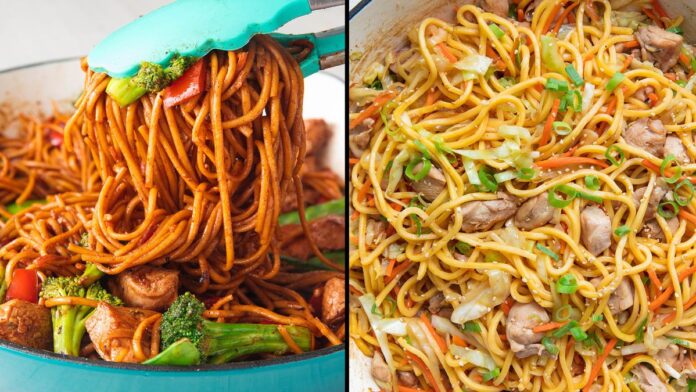Chow mein vs lo mein: two iconic Chinese noodle dishes that have captivated food enthusiasts with their distinct flavors and textures. Though often used interchangeably, these popular dishes showcase unique characteristics that set them apart.
From the crispy, stir-fried noodles of chow mein to the soft, tossed noodles of lo mein, each dish offers a delightful culinary experience.
In this article, we will delve into the world of chow mein and lo mein, exploring their origins, ingredients, cooking methods, and cultural significance. Get ready to unravel the delicious differences between chow mein and lo mein as we embark on a flavorful journey through these beloved Chinese noodle dishes.
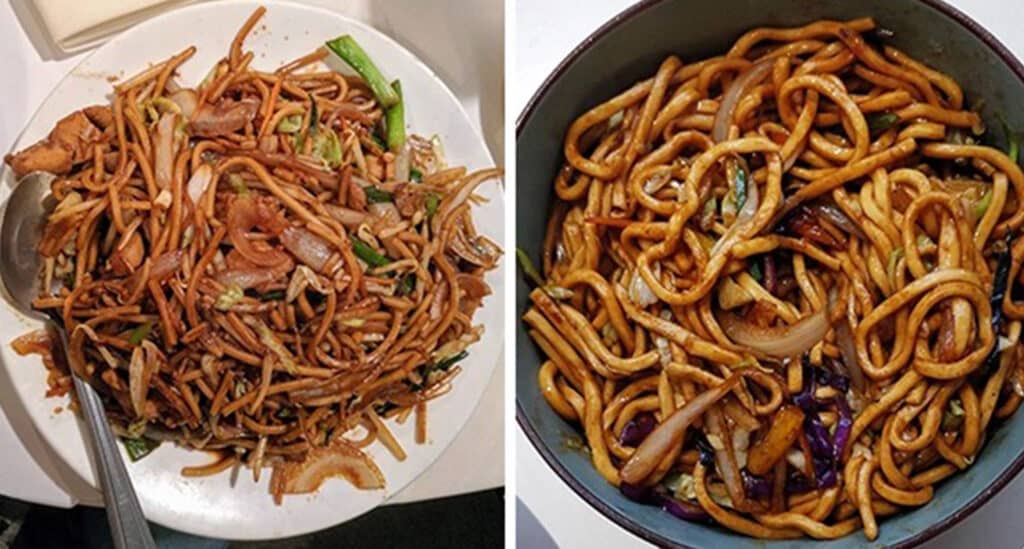
SEE ALSO:
- Chicken Noodle Soup Recipe
- Browning Sauce Recipe: 7 Interesting Things To Know
- Chow Mein Recipe (7 variations)
What is Chow Mein?
Chow mein is a popular Chinese dish consisting of stir-fried noodles, typically made from wheat flour, along with a variety of vegetables, meat, seafood, or tofu. The term “chow mein” translates to “fried noodles” in Cantonese. However, there are two types of chow me in noodles.
- Steamed chow mein: In steamed chow mein, the noodles are initially flash-fried, then stir-fried while being tossed with additional ingredients like meat or vegetables and coated in a light sauce.
- Crisp chow mein: When making crisp chow mein, the noodles are pressed flat while frying, creating a pancake-like dish. Any additional ingredients and sauces are layered on top of the noodle pancake.
The dish is prepared by stir-frying the noodles in a wok or a large pan with oil at high heat. This cooking method gives the noodles a slightly crispy texture. The vegetables and other ingredients are then added and stir-fried together with the noodles.
In making chow me in recipes, you only make use of a little sauce. Chow mein dishes don’t drown the noodles in sauce, letting the crunchy noodles shine without being soggy. Occasionally, a darker, richer sauce will accompany crisp chow mein, softening the noodles’ crisp exterior and giving them a chewier texture.
Tips to determine if you are eating Chow Mein
- If you are eating crisp chow mein, the noodles are distinctly crispy.
- Eating steamed chow me in, the noodles are more oily.
- The amounts of protein and vegetables are kept at a minimum.
- The sauce is lightly applied and does not overshadow or weigh down the noodles.
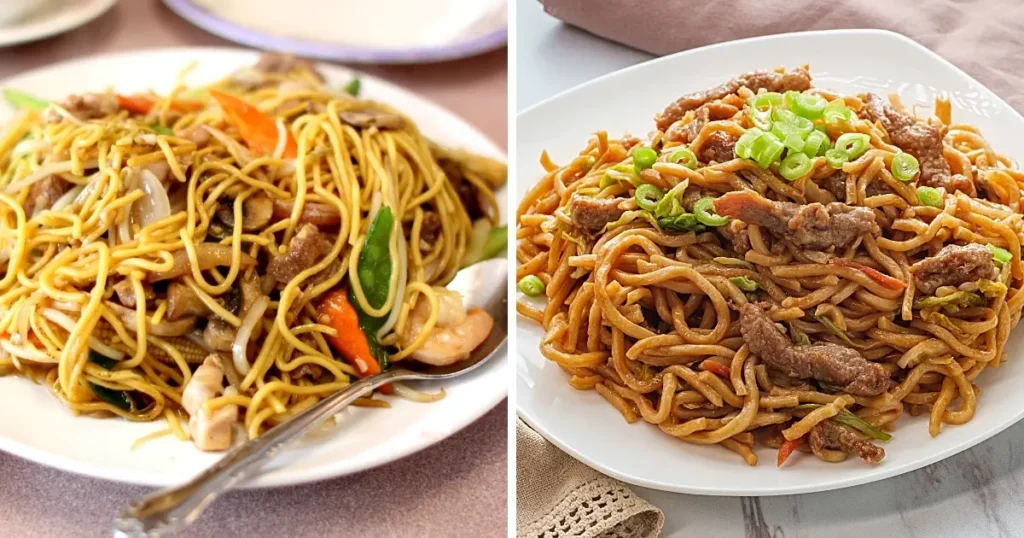
SEE ALSO: How Many Ounces in a Shot (Food Conversion Guide)
What is Lo Mein?
The term “lo mein” translates to “tossed noodles” in Cantonese, referring to the method of mixing the cooked noodles with the other ingredients. Unlike chow mein, which features crispy stir-fried noodles, lo mein noodles are soft and have a more elastic texture.
It consists of soft wheat noodles that are boiled until they become tender and then tossed with a variety of stir-fried vegetables, meat, seafood, or tofu.
Lo mein is made with fully cooked noodles that have been boiled and drained, similar to how ramen, udon, and soba noodles are prepared. These cooked noodles are added to a wok containing various vegetables and proteins that have already been cooked and tossed in the lo mein sauce.
All the ingredients are gently tossed together until the noodles are just heated through. You can now drizzle some extra sauce over the wok to complete the dish.
How to identify Lo Mein
- The noodles are not greasy
- The entire dish is coated with lo mein sauce to give it a bold flavor.
- The dish includes a considerable amount of veggies and protein, which have been mixed in with the noodles and sauce.
SEE ALSO: Tastiest Nigerian Street Foods
Chow Mein vs Lo Mein.
It is easier to confuse the two dishes together as they both have been to their end. however, “mein” simply means “noodles,” which means mixing up. Chow mein means fried noodles; lo mein translates to tossed or stirred noodles.
Because both dishes are variations of noodles, the main difference between chow mein and lo mein lies in how the noodles are prepared. Here’s a breakdown of the main differences between chow mein and lo mein:

1. Cooking method
Chow mein noodles are usually cooked by stir-frying them at high heat. This results in a slightly crispy texture and a more distinct flavor. Lo mein noodles, on the other hand, are boiled until they become soft and then mixed with the stir-fried ingredients.
2. Sauce
The sauce used in chow mein and lo mein can also differ. Chow mein typically has a thicker sauce that coats the noodles and ingredients, providing a rich flavor. Lo mein, on the other hand, often has a lighter sauce that is more like a glaze, allowing the flavors of the ingredients to shine through.
3. Ingredients
The choice of ingredients can vary in chow mein and lo mein, but both dishes typically include a mix of vegetables, meat or seafood, and sometimes tofu. The ingredients are often stir-fried together with the noodles in chow mein, while in lo mein, they are usually stir-fried separately and then combined with the noodles.
4. The texture
Chow mein noodles tend to be crunchier than lo mein noodles due to how they are cooked. Lo mein noodles are typically smoother and slightly chewy because they are fully cooked before being tossed with any extra ingredients and sauce. The noodles used to make a lo mein dish must also be thick and sturdy enough to support the weight of extra sauce.
Despite their differences, chow mein and lo mein dishes are made with Chinese egg noodles, and wheat flour noodles with egg added. While lo mein requires fresh egg noodles, chow mein can be made with either fresh or dried egg noodles.
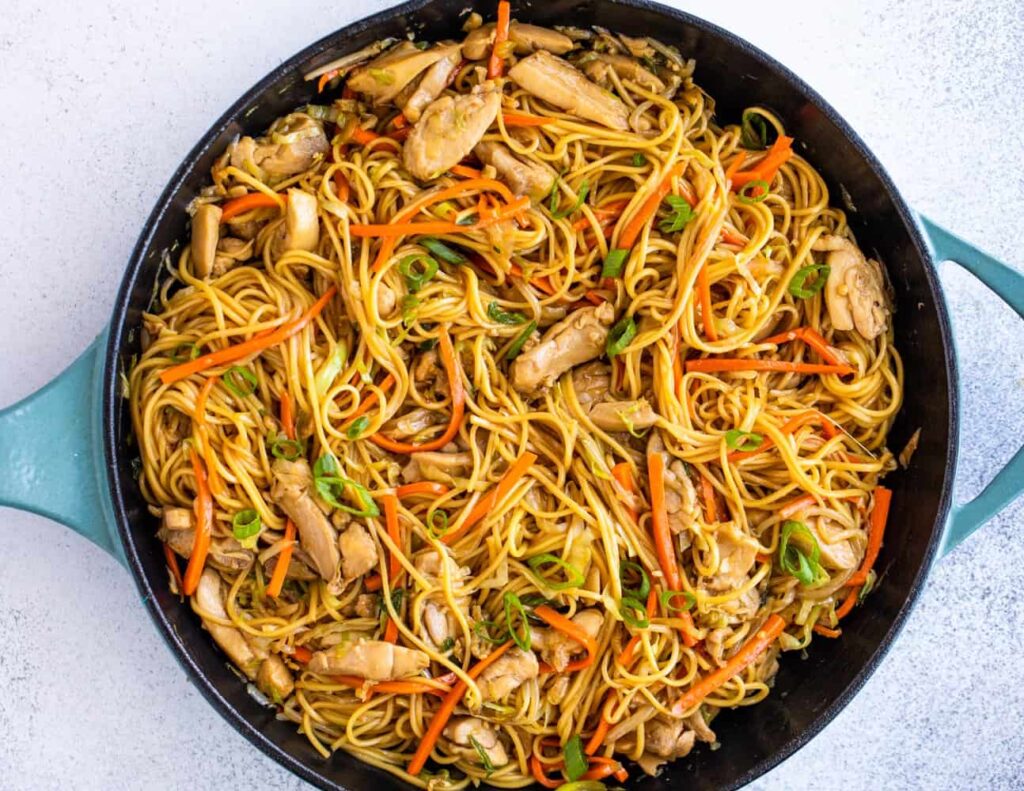
SEE ALSO: Eggy Bread Recipe: 4 Best Recipes to Try Out
How to make Chow Mein vs Lo Mein
Here is a basic recipe for making chow mein:
Ingredients
- 200g /6 oz chicken breast or thigh filets,
- 4 cups green cabbage,
- 1 ½ tbsp peanut oil
- 2 cloves garlic,
- 200g /6 oz chow mein noodles
- 1 carrot, julienned
- 1 ½ cups bean sprouts
- 3 green onions,
- ¼ cup (65 ml) water
Chow Mein Sauce
Chow mein sauce is an essential component of the dish, as it adds flavor and helps to coat the noodles and ingredients. While there are variations in chow mein sauce recipes, the following is a basic and versatile sauce that you can use for making chow mein:
- 2 tsp cornflour/cornstarch
- 1 ½ tbsp soy sauce, all-purpose or light
- 1 ½ tbsp oyster sauce (sub-Hoisin)
- 1 ½ tbsp Chinese cooking wine OR Mirin
- 2 tsp sugar (reduce to 1 tsp if using Mirin)
- ½ tsp sesame oil
- White pepper
SEE ALSO: Korean Corn Dog Home-made Recipes you could Try
Instructions
Sauce:
Mix cornflour and soy sauce, then mix in the remaining ingredients.
Alternative: Use ⅓ cup Chinese All Purpose Stir Fry Sauce if you have some in stock.
Chicken and Noodles
- Marinate Chicken: Pour 1 tbsp of Sauce over the chicken, mix to coat, and set aside to marinate for 10 minutes.
- Noodles: Prepare the noodles according to the packet instructions (my pack says soak in boiled water for 1 minute), then drain.
Cooking:
- Heat oil in a wok or large fry pan over high heat.
- Add garlic and stir fry for 10 seconds or until it starts to turn golden – don’t let it burn!
- Add chicken and stir fry until the surface gets a tinge of browning but the inside is still raw – about 1 minute.
- Add the cabbage, carrot, and white pieces of shallots (i.e., from the stalk’s base). Stir fry for 1 1/2 minutes until the cabbage is mostly wilted.
- Add the noodles, Sauce, and water. Stir fry for 1 minute, tossing constantly.
- Add bean sprouts and remaining shallots/scallions. Toss through for 30 seconds or until the bean sprouts wilt.
- Remove from heat and serve immediate
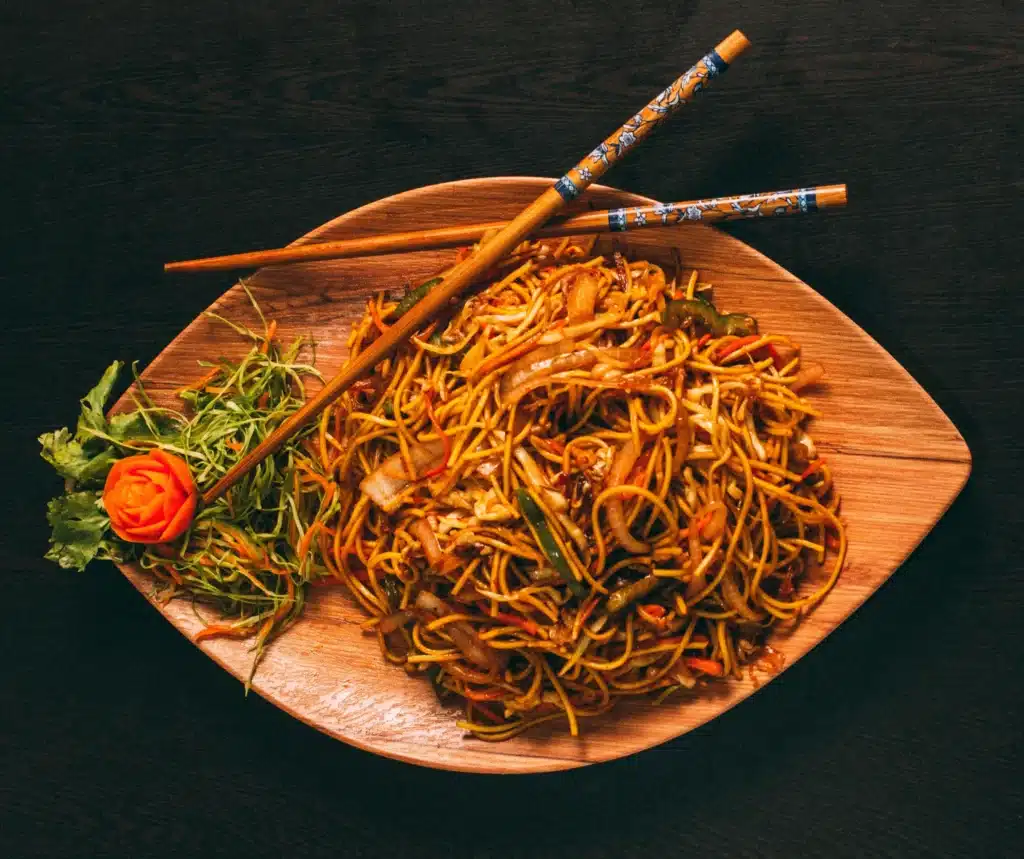
SEE ALSO: List of Easy Recipes for Picky Eaters
How to make Lo Mein
Here’s a basic recipe for Lo Mein
Ingredients
- 1.5 tbsp vegetable or peanut oil
- 2 garlic cloves, finely minced (Note 1)
- ½ onion, finely sliced
- 300g / 10 oz chicken or other protein,
- 2 medium carrots, peeled and cut
- 1 large red capsicum/bell pepper,
- 6 green onions, cut into
- 500g/1lb Lo Mein, Hokkien, or other medium-thickness egg noodles, fresh, prepared per packet
- 1/4 cup (65ml) water
Sauce:
- 4 tsp cornflour/cornstarch
- 2 tbsp dark soy sauce
- 2 tbsp soy sauce or light soy sauce
- 1 tbsp Chinese cooking wine or Mirin
- 1 tsp white sugar
- ½ tsp sesame oil, toasted, optional
- ¼ tsp white pepper
Garnish:
Green onion, finely sliced
SEE ALSO: 21 Kerala Famous Food
Instructions
- Sauce: Mix cornflour and dark soy until lump free, then add remaining Sauce ingredients.
- Season Chicken: Transfer 2 tsp Sauce into bowl with chicken. Toss to coat.
- Heat oil in a wok or large heavy-based skillet over high heat until smoking.
- Add onion and garlic, and stir for 30 seconds.
- Add chicken, and stir until white on the outside, still raw inside – 1 minute.
- Add carrot and capsicum/bell peppers, and cook for 2 minutes or until the chicken is cooked.
- Add noodles, Sauce, and water. Use 2 wooden spoons and toss for 30 seconds.
- Add green onions, and toss for another 1 minute until all the noodles are slick with sauce.
- Serve immediately, garnished with extra green onions if using.
SEE ALSO: 5 Easy Black Eyed Peas Recipe
Chow Mein vs Lo Mein Recipe Variations
Chow Mein Recipes
Here are a few variations of chow mein recipes that you can try:
1. Chicken chow mein
Chicken chow mein is an iconic Chinese takeout dish. You can whip up your chicken chow mein in minutes by following the chow mein instructions above and using chicken, shredded cabbage, julienned carrots, and green onions as your add-ins.
2. Shrimp chow mein
Have a seafood lover in your household? Shrimp chow mein will indeed become a new dinnertime favorite for anyone who enjoys seafood and Chinese cuisine. Simply combine shrimp, cabbage, carrots, and bean sprouts with your chow mein noodles to create this delicious dish.
3. Soy sauce chow mein
Ready to let your chow-mein sauce-making skills shine? A simple soy sauce chow mein seasons plain fried egg noodles with a mouthwatering blend of light soy sauce, dark soy sauce, oyster sauce, sesame oil, sugar, white pepper, and Shaoxing wine.
4. Beef Chow Mein
Thinly slice beef steak or use beef strips as the protein. Marinate the beef in a mixture of soy sauce, garlic, and a touch of cornstarch to tenderize it before stir-frying.
SEE ALSO: 10+ Worst Nigerian Food Combos You Should Definitely Try
Lo Mein Recipes
Here are a few variations of lo mein recipes that you can try:
1. Dan Dan noodles
If you’re looking for a dish with some heat, this Dan Dan noodles recipe is perfect as it incorporates Sichuan peppercorns and chili oil. You can also zest up your lo mein’s flavors by using a splash of Chinese cooking wine in its sauce.
2. Chicken lo mein
Chicken is the standard meat used in lo mein noodles. If you’re looking for a little extra protein with your noodles and want to try a classic Chinese takeout dish, add some stir-fried chicken to your lo mein. Be sure to cook the chicken in the lo mein sauce to take the dish’s flavors up a notch.
3. Szechuan Shrimp and Asparagus over Linguine
For those who love to think outside the box, this Szechuan Shrimp and Asparagus over linguine recipe will certainly satisfy your daring taste buds. This lo mein-style recipe fills the dish with impactful flavors while using linguine gives it a unique texture.
SEE ALSO: Best Vegetarian Recipes Just for You
Difference between Chow Mein and Lo Mein
SEE ALSO: How many Quarts in a Gallon (Food Measurements)
Conclusion
Chow mein and lo mein may fall under the Chinese noodle dishes’ umbrella, but their distinctions lie in their texture, cooking methods, and overall taste experience. Chow mein tantalizes with its crispy and firm noodles, while lo mein offers a comforting softness.
The stir-frying technique of chow mein results in a more intense flavor infusion, whereas lo mein allows the ingredients to shine through with its tossed noodle preparation.
Exploring the world of chow mein and lo mein reveals a delicious array of flavors and a glimpse into Chinese culinary traditions and regional variations. From vegetable-packed renditions to those featuring succulent proteins like chicken, beef, shrimp, or tofu, there is a chow mein or lo mein style to suit every palate.
Whether you prefer the satisfying crunch of chow mein or the silky tenderness of lo mein, both dishes have earned their rightful place in the hearts and stomachs of food enthusiasts worldwide.
So, the next time you find yourself contemplating which noodle dish to savor, you can confidently navigate the differences between chow mein and lo mein, appreciating the unique qualities and cultural heritage each brings.
SEE ALSO: How to Make the Best Fluffy American Pancake Recipe
FAQs About Chow Mein vs Lo Mein
Which is better, chow mein or lo mein?
The preference between chow mein and lo mein is subjective and depends on personal taste. Chow mein typically has crispy noodles, while lo mein has soft noodles. Some people prefer the texture and flavor of crispy chow mein noodles, while others enjoy the softer texture of lo mein noodles. It ultimately comes down to individual preference.
Is lo mein Chinese or Japanese?
Lo mein is a Chinese dish. It is a popular noodle dish in Chinese cuisine and can be found in various regional Chinese cuisines. While there are similar noodle dishes in Japanese cuisine, such as yakisoba, lo mein itself is of Chinese origin.
What is another name for lo mein?
In Cantonese cuisine, lo mein is sometimes referred to as “lou mein.” Both terms are used interchangeably to describe the same dish.
What is the meaning of lo mein?
The term “lo mein” translates to “stirred noodles” in Cantonese. It refers to the cooking technique of stir-frying noodles with various ingredients such as vegetables, meat, and sauces.
Why is it called chow mein?
The term “chow mein” translates to “fried noodles” in Cantonese. It is called chow mein because the dish traditionally involves frying the noodles until they become crispy. The crispy noodles are then topped with stir-fried vegetables, meat, and sauce.
Why do they call it lo mein?
The term “lo mein” translates to “stirred noodles” in Cantonese. It is called lo mein because the dish involves stir-frying the noodles with various ingredients and sauces. The noodles used in lo mein are typically soft, in contrast to the crispy noodles used in chow mein.



